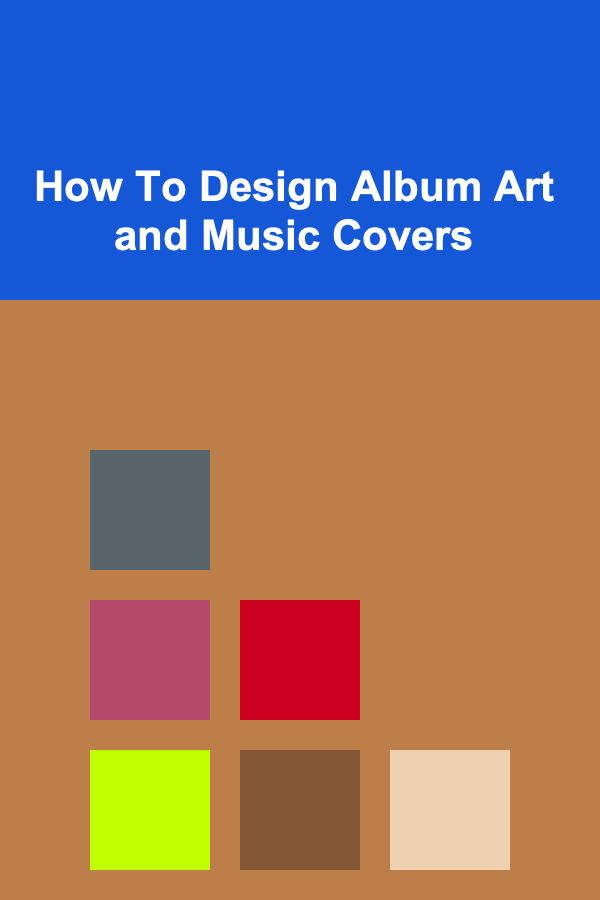
How To Design Album Art and Music Covers
ebook include PDF & Audio bundle (Micro Guide)
$12.99$7.99
Limited Time Offer! Order within the next:

Album art and music covers are essential visual elements that define the identity of a music album or single. They are the first impression that listeners get before even hearing a single note of music. As such, the design process behind album art is an intricate blend of creativity, branding, and conceptual communication. A well-designed album cover can amplify the emotional impact of the music and contribute to the artist's identity. This article delves into the process of designing album art and music covers, exploring the stages involved, creative concepts, and technical considerations.
The Significance of Album Art
Album art plays a significant role in music marketing. It's the visual representation of the music, and much like the sound of the album, it should evoke the mood, genre, and themes of the content within. The importance of album art can't be overstated --- in a world dominated by digital platforms like Spotify and Apple Music, album covers are often the first thing a potential listener sees when scrolling through their feed or playlist.
An album cover is an artist's opportunity to communicate without words. A successful album cover design doesn't merely present an image---it tells a story, creates an atmosphere, and helps connect the music to its audience. In some cases, it becomes iconic, just like the music itself. Examples such as Pink Floyd's The Dark Side of the Moon and Nirvana's Nevermind show how album art can become an indelible part of cultural history.
Understanding the Artist's Vision
Before diving into the design, the most important step is understanding the music and the artist's vision. This understanding helps ensure the design aligns with the tone of the album and accurately reflects the artist's image and message.
- Music Genre: Different genres have distinct visual styles. For example, electronic music often features futuristic, minimalist designs, while rock albums may opt for bold, rebellious imagery. The genre gives a good starting point for the creative direction.
- Artist's Brand: Is the artist known for vibrant visuals or minimalistic, dark designs? Their previous album art or public persona can offer guidance in the design process.
- Album Themes: The themes of the album are also critical to consider. A concept album will have different artistic needs compared to an album that is more personal or introspective. The themes should be reflected in the design to create a deeper connection with the listener.
By discussing with the artist (if you're not the one creating the music), understanding their goals for the album, and considering their visual identity, you can begin developing ideas that will shape the design process.
Research and Inspiration
Once you understand the artist's vision, it's time to gather inspiration and research. At this stage, you should explore existing album covers, art styles, and design trends that resonate with the project. It's important to recognize that the goal is not to copy existing work but to understand the essence of what makes certain designs successful and how they can inspire fresh, original ideas.
Research Components:
- Album Covers in the Same Genre: Look at album covers within the same genre or subgenre. Understand why certain colors, typography, or images are used and how these elements help convey the genre's feel.
- Art Movements: Explore art movements that could inform your design. For example, surrealism could work for an experimental album, while pop art might be more fitting for a vibrant, upbeat pop album.
- Photography Styles: If the album is more focused on the artist's persona, photography will play a key role. You can explore portrait photography, fashion photography, or abstract photography for inspiration.
- Color Theory: The psychology of color is important in design. Colors can evoke specific feelings or moods. For example, blue often conveys calmness or sadness, while red can represent energy or aggression. Choose colors that reflect the tone of the music.
With a wide range of references, you can begin sketching out visual directions and identifying the elements that will give the album its unique visual identity.
Design Elements to Consider
Creating an album cover involves balancing various design elements. These include imagery, typography, color, layout, and graphic elements. Each plays a significant role in crafting the overall design.
1. Imagery
Imagery is perhaps the most important aspect of album art. Whether you are using photography, illustrations, or a combination of both, the image chosen must evoke the emotions or themes within the album. Here are some considerations when choosing or creating imagery:
- Metaphorical or Literal Imagery: Consider whether the image should represent a metaphor related to the album's theme or if a literal representation of the music is more appropriate.
- Abstract vs. Concrete: Some albums work well with abstract or surreal imagery, while others need more direct, recognizable visuals.
- Artist Representation: If the album is deeply personal, a photo or illustration of the artist could be fitting. If the album has a broader or conceptual theme, the imagery could be more symbolic.
2. Typography
Typography is not just about choosing the right font---it's about how the typography fits within the overall design. Font choice can directly affect the mood and style of the album. For example, a gritty, hand-drawn font might suit a punk rock album, while a sleek, modern typeface could work for an electronic album.
- Font Styles: Choose a font that aligns with the genre and tone of the music. The typography should not compete with the imagery but complement it.
- Legibility: While creative fonts may look beautiful, it's important to ensure the text remains legible, especially the album name and artist's name.
- Placement: Typography placement should feel intentional. The album name, artist name, and other text should have a natural flow and not overwhelm the visual elements.
3. Color Palette
Colors are key to establishing the mood and atmosphere of the album art. A cohesive color palette enhances the overall design and strengthens the visual narrative.
- Mood Setting: A dark color palette might evoke mystery or sadness, while bright colors could create a sense of joy or energy. Colors should reflect the essence of the music.
- Contrast and Balance: Using contrasting colors can make the album art pop, while balancing light and dark tones ensures that the design isn't too overwhelming.
4. Layout and Composition
The layout involves the positioning of text and imagery, ensuring that all elements work together harmoniously. The composition of the design should be balanced, creating a visually engaging experience without overwhelming the viewer.
- Rule of Thirds: The rule of thirds is a widely used composition technique where the design is divided into three horizontal and vertical sections. This makes for a balanced and harmonious layout.
- Focus Points: Ensure the viewer's eye is drawn to the most important elements, such as the album title or artist name.
- Spacing: Don't overcrowd the design. White space can be just as impactful as the elements themselves, allowing the design to breathe.
Tools and Techniques for Design
The right tools can make the design process much smoother. While professional designers typically use software like Adobe Photoshop, Illustrator, or InDesign, there are also several other tools and platforms that can be used depending on your design skills.
1. Adobe Photoshop
Photoshop is perhaps the most popular tool for album art. It allows for intricate photo manipulation, graphic design, and illustration. It's perfect for those who want to combine photography with illustration or need to work with high-resolution images.
- Layering and Masking: Photoshop allows for complex layering techniques that can help you create dynamic, textured designs.
- Filters and Effects: Experimenting with filters, blending modes, and special effects can add an extra layer of creativity to your design.
2. Adobe Illustrator
For artists who focus on vector designs, Adobe Illustrator is an excellent tool. It's best for creating logos, icons, and illustrations that require scalability and precision.
- Vector Art: Create crisp, clean illustrations and graphics that retain their quality no matter the size of the album cover.
- Typography Control: Illustrator provides detailed typography control and advanced font manipulation.
3. Canva
Canva is a user-friendly, web-based design tool suitable for beginners or those who need a quick design solution. It comes with templates, stock images, and an intuitive drag-and-drop interface, making it accessible even for those with no design experience.
- Templates: Canva has a wide range of customizable templates for album covers that make it easy for newcomers to get started.
- Stock Elements: You can access an extensive library of free and premium graphics, illustrations, and photos.
Practical Considerations
While creativity is essential, practical considerations are just as important when designing album art. The final product should be adaptable across different media and platforms.
- Size and Resolution: Album art needs to be scalable and should look good in both small sizes (e.g., on a phone screen) and large sizes (e.g., on vinyl records). Typically, album covers are designed at 300 DPI (dots per inch) to ensure they maintain high quality.
- Platforms and Formats: Different platforms (e.g., iTunes, Spotify, physical CDs, vinyl) have different format requirements. Make sure your design is flexible enough to work across multiple formats.
- Copyright: If using photographs, illustrations, or graphics that are not your own, ensure that you have the proper licenses and rights to use them.
Conclusion
Designing album art and music covers is a process that requires a blend of creativity, technical knowledge, and an understanding of the music it represents. The album cover should capture the essence of the music, evoke the right emotions, and reflect the artist's identity. By combining research, thoughtful design choices, and the right tools, you can create a cover that stands out, resonates with listeners, and helps elevate the music itself. Ultimately, great album art becomes a visual extension of the music, a piece of the puzzle that brings the entire artistic experience to life.

Designing Success: Essential Skills for the Modern Graphic Designer
Read More
How to Build a Positive Body Image in Your Child
Read More
How to Determine the Ideal Rental Price for Your Property
Read More
How to Renovate Your Home for Aging in Place
Read More
What Steps Can You Take to Keep Your Fridge Organized?
Read More
How To Master Any Extreme Sport
Read MoreOther Products

Designing Success: Essential Skills for the Modern Graphic Designer
Read More
How to Build a Positive Body Image in Your Child
Read More
How to Determine the Ideal Rental Price for Your Property
Read More
How to Renovate Your Home for Aging in Place
Read More
What Steps Can You Take to Keep Your Fridge Organized?
Read More